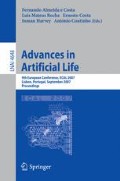Abstract
We describe two simple simulations in which artificial organisms evolve an ability to respond to inputs from within their own body and these inputs themselves can evolve. In the first simulation the organisms develop an ability to respond to a pain signal caused by body damage by stopping looking for food when they feel pain since resting while the body is damaged accelerates healing of the body and increases the individual’s survival chances. In the second simulation the pain signal itself evolves, that is, the body develops a tendency to send pain signals to the nervous system when the body is damaged. The results are discussed in terms of an internal robotics in which the robot’s body has an internal structure and not only an external morphology and the neural network that controls the robot’s behavior responds to inputs both from the external environment and from within the body.
Access this chapter
Tax calculation will be finalised at checkout
Purchases are for personal use only
Preview
Unable to display preview. Download preview PDF.
References
Archer, J.: The Nature of Grief. The Evolution and Psychology of Reaction to Loss. Routledge, London (1999)
Besson, J.M.: The neurobiology of pain. The Lancet 353, 1610–1615 (1999)
Bowlby, J.: Attachament and Loss, vol. 2. Separation: Anxiety and Anger. Hogart, London (1975)
Cangelosi, A., Parisi, D., Nolfi, S.: Cell division and migration in a ‘genotype’ for neural networks. Network 5, 497–515 (1994)
Cecconi, F., Parisi, D.: Neural networks with motivational units. In: Meyer, A.J., Roitblat, H.L., Wilson, S.W. (eds.) From animals to animats 2: Proceddings of the 2nd International Conference on Simulation of Adaptive Behavior, pp. 346–355. MIT Press, Cambridge (1993)
Fellous, J.M., Arbib, M. (eds.): Who needs Emotions? The Brain Meets the Robot. Oxford University Press, Oxford (2005)
Hendry, S.: Pain. In: Wilson, R., Keil, F. (eds.) MIT Encyclopedia of Cognitive Sciences, pp. 622–624. MIT Press, Cambridge (1999)
Loeser, J.D., Melzack, R.: Pain: an overview. The Lancet 353, 1607–1609 (1999)
Melzack, R.: The Puzzle of Pain. Basic Books, New York (1973)
Mirolli, M., Parisi, D.: Artificial organisms that sleep. In: Banzhaf, W., Ziegler, J., Christaller, T., Dittrich, P., Kim, J.T. (eds.) ECAL 2003. LNCS (LNAI), vol. 2801, pp. 377–386. Springer, Heidelberg (2003)
Nesse, R.M.: What good is feeling bad? The evolutionary benefits of psychic pain. The Sciences nov./dic, 30–37 (1991)
Nesse, R.M.: The Evolution of Hope and Despair. Social Research 66, 429–469 (1999)
Nesse, R.M.: Is depression an adaptation? Archives of General Psychiatry 57, 14–20 (2000)
Parisi, D.: Motivation in artificial organisms. In: Tascini, G., Esposito, V., Roberto, V., Zingaretti, P. (eds.) Machine Learning and Perception, pp. 3–19. World Scientific, Singapore (1996)
Parisi, D.: Internal robotics. Connection Science 16, 325–338 (2004)
Wall, P.: Pain. Weidenfeld and Nicolson, London (1999)
Willis, W.D.: The Pain System: The Neural Basis of Nociceptive Transmission in the Mammalian Nervous System. Kragel, Basel (1985)
Author information
Authors and Affiliations
Editor information
Rights and permissions
Copyright information
© 2007 Springer-Verlag Berlin Heidelberg
About this paper
Cite this paper
Acerbi, A., Parisi, D. (2007). The Evolution of Pain. In: Almeida e Costa, F., Rocha, L.M., Costa, E., Harvey, I., Coutinho, A. (eds) Advances in Artificial Life. ECAL 2007. Lecture Notes in Computer Science(), vol 4648. Springer, Berlin, Heidelberg. https://doi.org/10.1007/978-3-540-74913-4_82
Download citation
DOI: https://doi.org/10.1007/978-3-540-74913-4_82
Publisher Name: Springer, Berlin, Heidelberg
Print ISBN: 978-3-540-74912-7
Online ISBN: 978-3-540-74913-4
eBook Packages: Computer ScienceComputer Science (R0)

